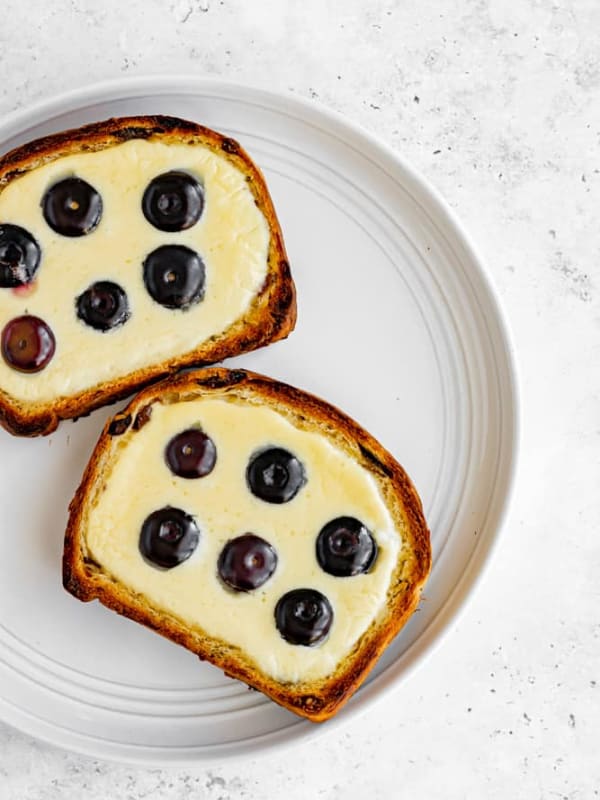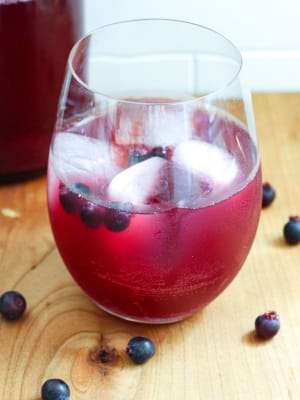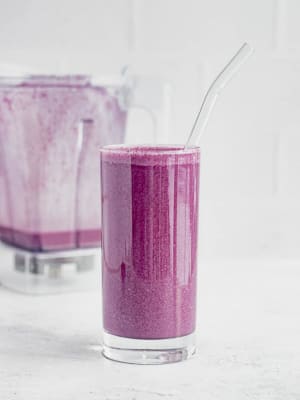Blueberries: Nature's Blue Diamonds

Blueberries: Nature's Blue Diamonds
The eye-popping indigo of bursting, juicy fresh blueberries at the height of the season in July or August is celebration-worthy.
Ancestral wisdom surrounding the healing power of wild blueberries, a true jewel of the native North American food pharmacy, goes back to various indigenous groups who have long recognized their culinary and medicinal uses.
The short version is that blueberries are very, very good for your health, but let's dive deeper.

Nutrients
Blueberries get their astounding colour from anthocyanins, an intensely pigmented subtype of antioxidants that fall under the polyphenol category. Polyphenols are plant compounds that offer various health benefits, most notably their protective effects on the brain and heart.
Blueberries are very low on the glycemic index and boast a profoundly high micronutrient to calorie ratio, making them an excellent snack compatible with almost any diet.
A deluxe rainbow of minerals and nutrients awaits the unsuspecting mucher. These blue gems are packed with Vitamin C, flavonoids, resveratrol, ellagic acid, pectin fibre, terpenes, omega 3 and 6 fatty acids. Blueberries are most bioactive when ripe, so to get the most from them, look for them at their bluest.

Health Benefits
The phrase 'superfood' gets thrown around a lot these days, but it is hard to describe blueberries in any other way.
Often people think of antioxidants as compounds that combat free radicals as they encounter them in circulation. While this is partially how the antioxidants in blueberries work, something much more complex is also happening. There are compounds in blueberries that "switch on" complex metabolic pathways in our biology to stimulate the production of hundreds of our own antioxidant enzymes.
This distinction between "passive" antioxidants in plant foods and "active" antioxidants produced in our cells must be understood for an authentic, functional food like blueberries to be adequately appreciated.
It also goes a long way in explaining why these berries are so effective at:
- dropping systemic inflammation
- squashing free radical damage
- stopping the spread of cancerous cells and sensitizing them to radiation
- strengthening the mucosal barrier of the gut
- promoting increased muscle growth
- positively affecting every aspect of cardiovascular function, from lowering high blood pressure to preserving and optimizing arterial health

Blueberry Derived Neurotrophic Factor
The antioxidant signalling ability of blueberries has a particular affinity for the brain, protecting it from free radical damage associated with neurological degradation and cognitive decline.
If that wasn't enough, blueberry polyphenols can decrease neurological inflammation, raise neuroplasticity (i.e. connectivity and cross-talk between brain cells), and improve memory and overall mental function. To put it more succinctly, they slow the rate at which your brain ages.
Astonishingly, they even help our brain regenerate. This process is thanks to a remarkable compound called Brain-Derived Neurotrophic Factor (BDNF). BDNF does something we thought was impossible in humans until recently: it promotes the generation of brand new brain cells. This neurogenesis effect has earned BDNF the nickname "Miracle-Gro for the brain." Blueberries are dense repositories of phytochemicals that significantly increase our body's production of BDNF.

Pterostilbene
One compound that has been receiving a lot of attention recently is pterostilbene. This increasingly famous polyphenol antioxidant is a major reason why blueberries continue to get studied for their health benefits.
Chemically it is almost identical to resveratrol; a longevity superstar in its own right, found in trace amounts in blueberries but mainly associated with red grape skins. However, pterostilbene is much more bioavailable. It even crosses the notoriously picky blood-brain barrier where it can do its neuroinflammation lowering, and BDNF raising magic.
Pterostilbene is a big part of how these superfruits benefit nearly every aspect of heart and brain health, switching off inflammation and oxidative damage throughout the vasculature and nervous system.
Interestingly, blueberries and pterostilbene are gaining repute among athletes for their ability to activate the AMP-activated protein kinase (AMPK) metabolic pathway. AMPK plays an important role in maintaining cellular energy. In a nutshell, the pterostilbene found in blueberries can assist with blood sugar regulation, lower systemic inflammation, activate autophagy and even increase the bliss molecule "anandamide" associated with the "runner's high" sensation.
More Than Meets the Eyes
The chemistry of blueberries, like any true functional food, is extremely complex because it involves scores of plant chemicals working in concert with our own endlessly intricate physiology. It is likely that future scientific research will largely colour in the details of what we already understand: blueberries go far beyond earning their superfood moniker.
Blueberries are potent activators of sweeping metabolic cascades across a myriad of tissues and organ systems, all working in breathtakingly coordinated and elaborate ways to keep us feeling younger, smarter and more vital.
Auon, L. (2020, January 20). Know this chemical in blueberries: Pterostilbene. Ergogenic Health. Retrieved February 28, 2023, from https://www.ergogenic.health/blog/know-this-chemical-in-blueberries
Biochemical Society. (2015, January 21). KEAP1-Nrf2 signaling: Adaptive responses to exogenous and endogenous stress. YouTube. Retrieved February 28, 2023, from https://www.youtube.com/watch?v=iv5ceFD19WQ
Blakely, J. (2018, November 13). Native fruit: The wild blueberry. Smithsonian Libraries and Archives / Unbound. Retrieved February 28, 2023, from https://blog.library.si.edu/blog/2018/11/13/native-fruit-the-wild-blueberry/#.YufjaSvMJEY
Casadesus, G., Shukitt-Hale, B., Stellwagen, H. M., Zhu, X., Lee, H. G., Smith, M. A., & Joseph, J. A. (2004). Modulation of hippocampal plasticity and cognitive behavior by short-term blueberry supplementation in aged rats. Nutritional neuroscience, 7(5-6), 309–316. https://doi.org/10.1080/10284150400020482
Dodd, G. F. (1970, January 1). The acute effects of flavonoid-rich blueberries on cognitive function in healthy younger and older adults. British Library EThOS - Search and order theses online. Retrieved February 28, 2023, from https://ethos.bl.uk/OrderDetails.do?uin=uk.bl.ethos.607157
Dunford, N. T. (2022). Blueberries and health. Functional Food Science, 2(1), 1. https://doi.org/10.31989/ffs.v2i1.875
El-Alfy, A., Patel, C., Mazhari, N., & Rimando, A. (2014, April 1). Inhibition of FAAH enzyme by pterostilbene: potential mechanism of anxiolytic action. Federation of American Societies for Experimental Biology (FASEB). Retrieved February 28, 2023, from https://faseb.onlinelibrary.wiley.com/doi/10.1096/fasebj.28.1_supplement.1144.10
FoundMyFitness Clips. (2020, January 6). Nrf2 pathway as the mechanism behind sulforaphane's protective effects | Jed Fahey. YouTube. Retrieved February 28, 2023, from https://www.youtube.com/watch?v=IoKGcsRH0Mg
Kuester, L. (n.d.). Top 10 foods to boost your BDNF. Amos Institute. Retrieved February 28, 2023, from https://amosinstitute.com/blog/top-10-foods-to-boost-your-bdnf/ Poulose SM, Miller MG, Scott T, Shukitt-Hale B. Nutritional Factors Affecting Adult Neurogenesis and Cognitive Function. Adv Nutr. 2017 Nov 15;8(6):804-811. doi: 10.3945/an.117.016261. PMID: 29141966; PMCID: PMC5683005.
Li, Y.-R., Li, S., & Lin, C.-C. (2017, December 6). Effect of resveratrol and pterostilbene on aging and longevity. IUBMB Journals. Retrieved February 28, 2023, from https://iubmb.onlinelibrary.wiley.com/doi/10.1002/biof.1400
Lin, V. C., Tsai, Y. C., Lin, J. N., Fan, L. L., Pan, M. H., Ho, C. T., Wu, J. Y., & Way, T. D. (2012). Activation of AMPK by pterostilbene suppresses lipogenesis and cell-cycle progression in p53 positive and negative human prostate cancer cells. Journal of agricultural and food chemistry, 60(25), 6399–6407. https://doi.org/10.1021/jf301499e
Lin, W.S., Leland, J. V., Ho, C.-T., & Pan, M.-H. (2020, February 15). Occurrence, Bioavailability, Anti-inflammatory, and Anticancer Effects of Pterostilbene. Journal of Agriculture and Food Chemistry. Retrieved February 28, 2023, from https://pubs.acs.org/doi/10.1021/acs.jafc.9b07860
McCormack, D., & McFadden, D. (2013). A review of pterostilbene antioxidant activity and disease modification. Oxidative medicine and cellular longevity, 2013, 575482. https://doi.org/10.1155/2013/575482
Rendeiro, C., Vauzour, D., Rattray, M., Waffo-Téguo, P., Mérillon, J. M., Butler, L. T., Williams, C. M., & Spencer, J. P. (2013). Dietary levels of pure flavonoids improve spatial memory performance and increase hippocampal brain-derived neurotrophic factor. PloS one, 8(5), e63535. https://doi.org/10.1371/journal.pone.0063535
Rodriguez-Mateos, A., Rendeiro, C., Bergillos-Meca, T., Tabatabaee, S., George, T. W., Heiss, C., & Spencer, J. P. (2013). Intake and time dependence of blueberry flavonoid-induced improvements in vascular function: a randomized, controlled, double-blind, crossover intervention study with mechanistic insights into biological activity. The American journal of clinical nutrition, 98(5), 1179–1191. https://doi.org/10.3945/ajcn.113.066639
Tobar-Bolaños, G., Casas-Forero, N., Orellana-Palma, P., & Petzold, G. (2021, October 29). Blueberry juice: Bioactive compounds, health impact, and concentration technologies—A review. Journal of Food Science. Retrieved February 28, 2023, from https://ift.onlinelibrary.wiley.com/doi/full/10.1111/1750-3841.15944
Tran, P. H. L., & Tran, T. T. D. (2021, January 14). Blueberry supplementation in neuronal health and protective technologies for efficient delivery of Blueberry Anthocyanins. MDPI. Retrieved February 28, 2023, from https://www.mdpi.com/2218-273X/11/1/102/htm
Travica, N., D'Cunha, N. M., Naumovski, N., Kent, K., Mellor, D. D., Firth, J., Georgousopoulou, E. N., Dean, O. M., Loughman, A., Jacka, F., & Max, W. (2019, April 15). The effect of blueberry interventions on cognitive performance and mood: A systematic review of randomized controlled trials. Brain, Behavior, and Immunity. Retrieved February 28, 2023, from https://www.sciencedirect.com/science/article/abs/pii/S0889159118311954?via%3Dihub
WholisticMatters. (2022, April 3). Best herbs for supporting the Nrf2 response. YouTube. Retrieved February 28, 2023, from https://www.youtube.com/watch?v=UV3FRGqU07U
WholisticMatters. (2022, October 31). Nrf2 and Detox support - nutrition education from WholisticMatters. WholisticMatters. Retrieved February 28, 2023, from https://wholisticmatters.com/nrf2-detox-support/
Xue, E. X., Lin, J. P., Zhang, Y., Sheng, S. R., Liu, H. X., Zhou, Y. L., & Xu, H. (2017). Pterostilbene inhibits inflammation and ROS production in chondrocytes by activating Nrf2 pathway. Oncotarget, 8(26), 41988–42000. https://doi.org/10.18632/oncotarget.16716





